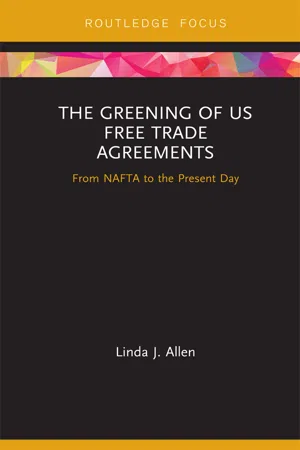The integration of environmental policies into US trade agreements is a relatively new phenomenon that emerged in the early 1990s as a result of the convergence of a couple of factors, in particular, the increasing awareness and political saliency of the social costs of freer trade and a renewed involvement of Congress in trade policy negotiations through the delegation of fast-track authority. Thus, to set the context for the subsequent discussion on the history of environmental and trade policy integration for US trade agreements, a little background is first provided on the overall process for crafting and enacting trade policy in the US as well as the increased awareness of the social costs of trade liberalization in the 1980s.
Trade policymaking in the US
The US Constitution provides the legal foundation for formulating trade policy in the US; Congress has the sole authority to regulate foreign trade, while the president has the exclusive authority to negotiate treaties and international agreements with other countries (Fergusson & Davis, 2018). Trade policymaking for most of US history dating back to the late 18th century largely consisted of Congress directly setting tariffs (Fergusson, 2015). However, during the latter half of the 20th century, trade policymaking evolved into a more complex process that involved both the president and Congress and sought to balance competing economic policy interests as well as non-economic policy interests while also reducing tariff and non-tariff barriers to trade (Destler & Balint, 1999; Fergusson, 2015).
Prior to 1934, US trade policy was focused exclusively on setting tariffs, undertaken by Congress without the involvement of the president (USITC, 2009). These policies, however, were often strongly influenced by domestic politics, resulting in fluctuating tariffs and at times high levels of protectionism (Fergusson & Davis, 2018). To better insulate the setting of tariffs from the influence of domestic politics, a new approach to trade policymaking was established by the Reciprocal Trade Agreements Act (RTAA) of 1934 (Destler, 1991). Under the RTAA, the president was delegated temporary authority to negotiate and sign reciprocal trade agreements to reduce tariffs without any additional legislative action by Congress, and this approach to setting trade policy prevailed until the early 1970s (Fergusson & Davis, 2018). While presidents are also influenced by domestic politics, when it comes to trade policy, they are typically focused on serving a national constituency and thus are much less parochial in their policy goals than members of Congress (Destler, 1991).
By the 1970s, overall tariff levels on many goods had been significantly reduced, and trade policy was increasingly touching upon non-tariff barriers, such as subsidies, procurement codes, product standards, and anti-dumping measures (USITC, 2009; Aaronson, 2001; Fergusson & Davis, 2018). In response, Congress substantively modified the authority delegated to the president, under the Trade Act of 1974, to allow for inclusion of the non-tariff issues in trade policy negotiations (Fergusson & Davis, 2018). At the same time, Congress also reasserted its authority to approve any final trade agreement in the new Trade Act (Fergusson & Davis, 2018). Trade agreements now had to be submitted for Congressional approval but would be given expedited consideration without the potential for amendments, under a delegated authority known as “fast-track” authority (Fergusson & Davis, 2018; USITC, 2009). Similar to the delegated authority under the RTAA, the new fast-track authority was for a defined period of time and required periodic renewal by Congress (Fergusson, 2015).
In conjunction with the new requirement for Congressional approval of any final trade agreement negotiated by the president, Congress also set forth under the Trade Act of 1974 its authority to establish negotiating objectives for new trade agreements and other procedural requirements, such as the president notifying and consulting with the legislators before, during, and after the negotiation process (Fergusson & Davis, 2018). Overall, these changes to the delegation of negotiating authority to the president for trade policy allowed for a reintroduction of domestic politics to some degree into the ...
